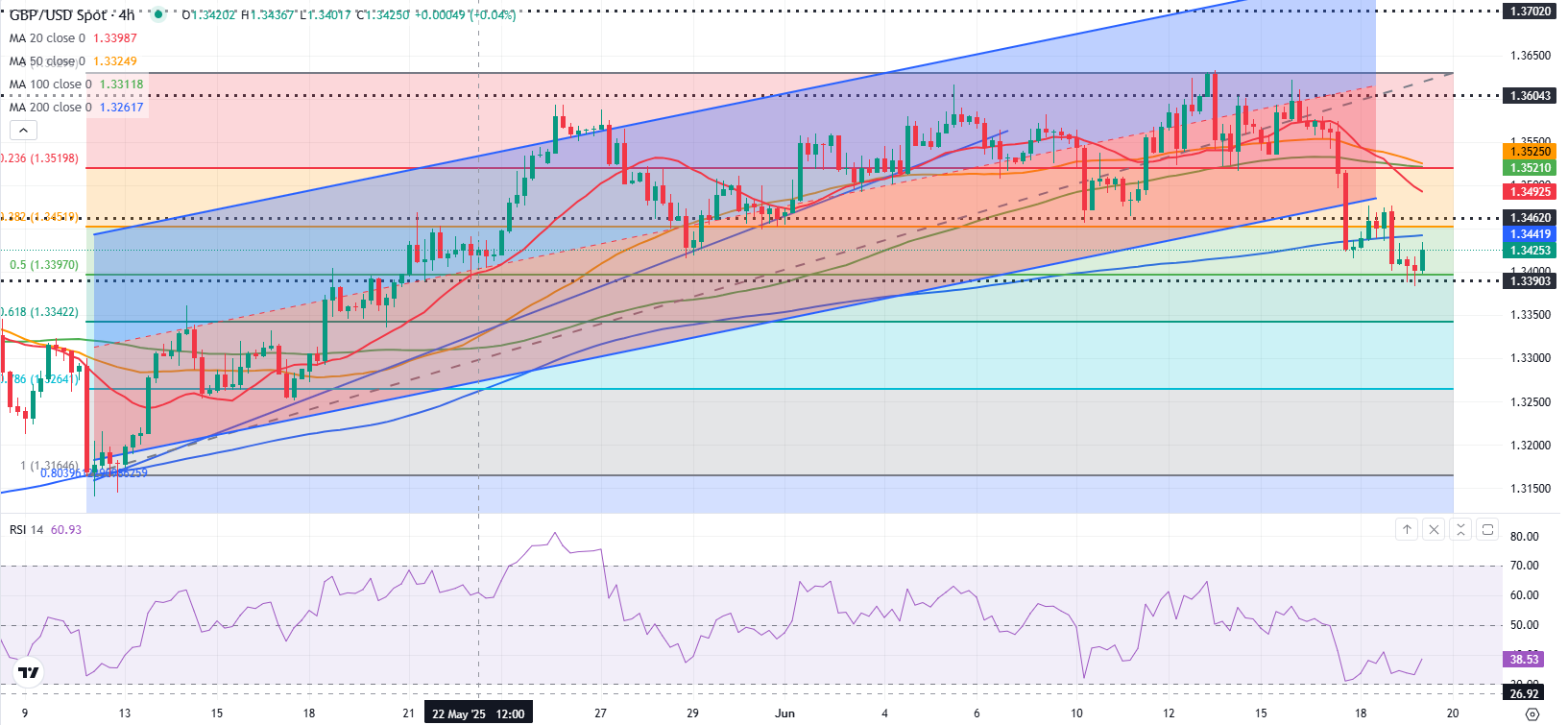
- GBP/USD stays in a consolidation phase above 1.3400 on Thursday.
- The BoE is expected to maintain its bank rate at 4.25% after June meeting.
- The risk-averse market atmosphere could make it difficult for the pair to stage a rebound.
After closing the day virtually unchanged on Wednesday, GBP/USD edged lower and touched its weakest level in about a month near 1.3380 in the Asian session on Thursday. Although the pair managed to recover above 1.3400 by the European morning, it’s struggling to attract buyers ahead of the Bank of England’s (BoE) policy announcements.
British Pound PRICE This week
The table below shows the percentage change of British Pound (GBP) against listed major currencies this week. British Pound was the weakest against the US Dollar.
| USD | EUR | GBP | JPY | CAD | AUD | NZD | CHF | |
|---|---|---|---|---|---|---|---|---|
| USD | 0.56% | 1.05% | 0.52% | 0.91% | 0.15% | 0.56% | 0.54% | |
| EUR | -0.56% | 0.38% | -0.05% | 0.35% | -0.28% | -0.00% | -0.02% | |
| GBP | -1.05% | -0.38% | -0.39% | -0.02% | -0.65% | -0.36% | -0.40% | |
| JPY | -0.52% | 0.05% | 0.39% | 0.38% | -0.68% | -0.32% | -0.40% | |
| CAD | -0.91% | -0.35% | 0.02% | -0.38% | -0.67% | -0.34% | -0.37% | |
| AUD | -0.15% | 0.28% | 0.65% | 0.68% | 0.67% | 0.29% | 0.26% | |
| NZD | -0.56% | 0.00% | 0.36% | 0.32% | 0.34% | -0.29% | -0.03% | |
| CHF | -0.54% | 0.02% | 0.40% | 0.40% | 0.37% | -0.26% | 0.03% |
The heat map shows percentage changes of major currencies against each other. The base currency is picked from the left column, while the quote currency is picked from the top row. For example, if you pick the British Pound from the left column and move along the horizontal line to the US Dollar, the percentage change displayed in the box will represent GBP (base)/USD (quote).
The BoE is widely expected to maintain its bank rate at 4.25% following the 25 basis points (bps) cut announced in May. Because there will not be a press conference, the vote split and the language in the policy statement could drive Pound Sterling’s valuation in the near term.
In case the vote is unanimous for a policy hold, the immediate reaction could help Pound Sterling gather strength. On the flip side, GBP/USD could continue to stretch lower if more than two policymakers vote in favor of a rate cut.
Meanwhile, the US Dollar (USD) stays resilient against its peers on Thursday and limits GBP/USD’s upside. The Federal Reserve’s (Fed) cautious tone and the risk-averse market atmosphere support the USD.
The Fed left the policy rate unchanged at the range of 4.25%-4.5% after the June meeting, as expected, and the revised Summary of Economic Projections (SEP) showed that policymakers still see a 50 bps reduction in the policy rate in 2025. On a hawkish revision, the document highlighted that officials now forecast only a 25 bps cut in 2026, against the 50 bps projected in March’s SEP.
In the post-meeting press conference, Fed Chairman Jerome Powell noted that there is unusually elevated uncertainty in the outlook and said that they expect goods inflation to rise further this summer, with tariffs working their way to the consumer. Powell also reiterated that they are well-positioned to wait before deciding on the next policy step.
Meanwhile, markets grow anxious as tensions in the Middle East remain high, with the possibility of the United States (US) directly getting involved in the Iran-Israel conflict. Bloomberg reported early Thursday that US officials are preparing for a possible strike on Iran in coming days. Additionally, the Wall Street Journal claimed that US President Donald Trump has approved attack plans on Iran earlier this week but wanted to wait to see if Tehran would abandon its nuclear program.
GBP/USD Technical Analysis

GBP/USD remains below the lower limit of the ascending regression and channel and stays below the 200-period Simple Moving Average after closing the previous four 4-hour candles below that level, reflecting a bearish tilt in the near term.
On the downside, 1.3400 (Fibonacci 50% retracement of the latest uptrend) aligns as the immediate support level before 1.3340 (Fibonacci 61.8% retracement) and 1.3300 (static level, round level). Looking north, resistance levels could be spotted at 1.3440-1.3450 (200-period SMA, Fibonacci 38.2% retracement and 1.3520 (Fibonacci 23.6% retracement, 100-period SMA).
Pound Sterling FAQs
The Pound Sterling (GBP) is the oldest currency in the world (886 AD) and the official currency of the United Kingdom. It is the fourth most traded unit for foreign exchange (FX) in the world, accounting for 12% of all transactions, averaging $630 billion a day, according to 2022 data. Its key trading pairs are GBP/USD, also known as ‘Cable’, which accounts for 11% of FX, GBP/JPY, or the ‘Dragon’ as it is known by traders (3%), and EUR/GBP (2%). The Pound Sterling is issued by the Bank of England (BoE).
The single most important factor influencing the value of the Pound Sterling is monetary policy decided by the Bank of England. The BoE bases its decisions on whether it has achieved its primary goal of “price stability” – a steady inflation rate of around 2%. Its primary tool for achieving this is the adjustment of interest rates. When inflation is too high, the BoE will try to rein it in by raising interest rates, making it more expensive for people and businesses to access credit. This is generally positive for GBP, as higher interest rates make the UK a more attractive place for global investors to park their money. When inflation falls too low it is a sign economic growth is slowing. In this scenario, the BoE will consider lowering interest rates to cheapen credit so businesses will borrow more to invest in growth-generating projects.
Data releases gauge the health of the economy and can impact the value of the Pound Sterling. Indicators such as GDP, Manufacturing and Services PMIs, and employment can all influence the direction of the GBP. A strong economy is good for Sterling. Not only does it attract more foreign investment but it may encourage the BoE to put up interest rates, which will directly strengthen GBP. Otherwise, if economic data is weak, the Pound Sterling is likely to fall.
Another significant data release for the Pound Sterling is the Trade Balance. This indicator measures the difference between what a country earns from its exports and what it spends on imports over a given period. If a country produces highly sought-after exports, its currency will benefit purely from the extra demand created from foreign buyers seeking to purchase these goods. Therefore, a positive net Trade Balance strengthens a currency and vice versa for a negative balance.
Information on these pages contains forward-looking statements that involve risks and uncertainties. Markets and instruments profiled on this page are for informational purposes only and should not in any way come across as a recommendation to buy or sell in these assets. You should do your own thorough research before making any investment decisions. FXStreet does not in any way guarantee that this information is free from mistakes, errors, or material misstatements. It also does not guarantee that this information is of a timely nature. Investing in Open Markets involves a great deal of risk, including the loss of all or a portion of your investment, as well as emotional distress. All risks, losses and costs associated with investing, including total loss of principal, are your responsibility. The views and opinions expressed in this article are those of the authors and do not necessarily reflect the official policy or position of FXStreet nor its advertisers. The author will not be held responsible for information that is found at the end of links posted on this page.
If not otherwise explicitly mentioned in the body of the article, at the time of writing, the author has no position in any stock mentioned in this article and no business relationship with any company mentioned. The author has not received compensation for writing this article, other than from FXStreet.
FXStreet and the author do not provide personalized recommendations. The author makes no representations as to the accuracy, completeness, or suitability of this information. FXStreet and the author will not be liable for any errors, omissions or any losses, injuries or damages arising from this information and its display or use. Errors and omissions excepted.
The author and FXStreet are not registered investment advisors and nothing in this article is intended to be investment advice.








